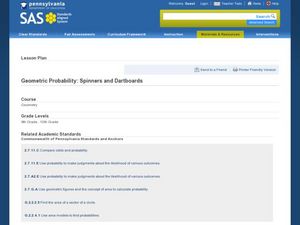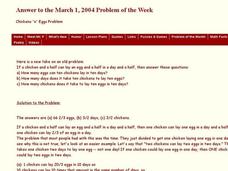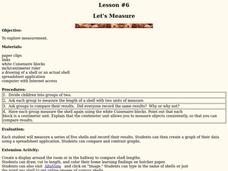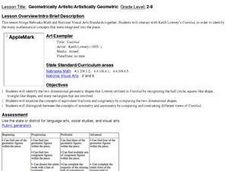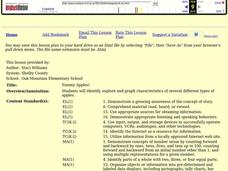Curated OER
Ordering Numbers
Seventh graders compare and contrast positive and negative numbers. They create a T-Chart and list real word examples of positive an negative numbers. After observing an number line and a football field, 7th graders describe the...
Curated OER
Using CAS and algebra tiles with Expanding and factoring trinomials
Ninth graders investigate multiplication of binomials and factoring of trinomials. In this Algebra I lesson, 9th graders compare and contrast expansion and factoring using algebra tiles and a TI-89.
Curated OER
Heart Rate Graphs
In this graphing learning exercise, 5th graders use a line graph to compare and contrast the heartbeats of two athletes in a tennis match.
Curated OER
Use Information in Line, Bar, Circle, and Picture Graphs to Make Comparisons and Predictions
Eighth graders explore the concept of graphs. In this graphs lesson, 8th graders compare and contrast picture graphs, bar graphs, line graphs, and circle graphs. Students examine each type of graph and answer questions and make...
Curated OER
Geometric Probablitiy: Spinners and Dartboards
Sstudents explore and analyze the properties of geometric areas. In this geometry lesson, sstudents use technology to simulate spinners and dartboards in order to fing areas of circles and sectors of circles and compare and contrast...
Curated OER
Chicken 'n' Eggs Problem
In this consumer mathematics instructional activity, high schoolers compare and contrast the details and costs of different trips. The one page instructional activity contains one problem. Answers are not provided.
Curated OER
Deductive Reasoning
Tenth graders investigate deductive reasoning. In this geometry lesson, 10th graders compare and contrast inductive ns deductive reasoning. Students use deductive reasoning to investigate algebraic proof and explore deductive geometric...
Curated OER
Introduction to Earning Interest: What are APR and APY?
Students explore saving and investing money. In this middle school personal finance lesson, students define and use investment vocabulary, explore compound interest and its effect of savings, and compute simple and compound interest. ...
Curated OER
Probability
In this Algebra II learning exercise, 11th graders compare and contrast experimental probability and theoretical probability. The two page learning exercise contains explanation of topic, worked examples, and seven practice problems....
Curated OER
What are the Odds
Young scholars predict the-outcome of an event. In this algebra lesson, students compare and contrast the probability of an event occurring. They calculate the odds of a simple event and make estimation.
Curated OER
Real Numbers in the Real World
Delve into the concept of operating on the set of real numbers! In this operating with the set of real numbers lesson, pupils perform order of operations on the set of real numbers using a calculator.
Curated OER
Everyone has a Culture-Everyone is Different
Young scholars explore cultural features. In this multicultural acceptance lesson, students define and discuss "culture," and distinguish the difference between individual characteristics and cultural characteristics. Young scholars...
K5 Learning
Ned and Rover and Jack
This isn't your ordinary short story with questions; it's actually two tales in one. First, find out what happens with Ned and Rover, then switch characters to discover the what happens between Jack and Rover.
August House
Anansi Goes to Lunch - Kindergarten
Greed is the theme of the West African folktale, Anansi Goes to Lunch and this multidisciplinary collection of lessons. First, scholars listen to a read aloud and participate in a grand conversation about the book's key details and...
College Board
Random Variables vs. Algebraic Variables
Variables can vary in meaning. A reference material for AP® Statistics explains the difference between random and algebraic variables. It provides a hypothetical situation involving dice—great for use in a classroom situation.
Curated OER
The Periodic Table
Eighth graders read and interpret the Periodic Table. They also make decisions on how to group and arrange different kinds of matter and draw the structure of atoms of pure elements. Finally, 8th graders contrast and compare basic...
Curated OER
Familia Romana
Students compare and contrast ancient family life to present day family life. In this Roman family life lesson plan, students discuss the roles present in their families and then learn about family life in ancient Rome. Students...
Curated OER
I. M. Pei and the Geometry of the NGA
Learners compare design elements in neoclassical and modern architecture. They review knowledge of triangles and quadrilaterals and design a geometric pattern using Pei's polygons They create a city plan using a variety of lines and...
Curated OER
Sizing Up the Supersize Croc
Learners examine and compare traits of humans and crocodiles. In this crocodile lesson students use a ratio to estimate the height of a person and compare that to a crocodile.
Curated OER
Let's Measure
Students measure shells using 3 different methods. In this measurement lesson, students work in two groups to measure the length of a shell using two different units of measure. The groups compare their results, measure the shell again...
Curated OER
Geometrically Artistic/Artistically Geomtric
Students identify the two-dimensional geometric shapes Lowrey utilized in the painting Untitled. Students compare the two-dimensional shapes in terms of equivalent fractions, congruency, symmetry and asymmetry. Students create their own...
Curated OER
Human Abstraction
Students explore and compare abstraction of human forms in various ancient cultures and by creating self-portraits using geometric shapes. They identify which geometric shapes form the following features: face, nose, arms, torso, legs,...
Curated OER
Baseball Statistics
Students take an in depth examine baseball record breakers. They calculate statistics, not just for one year, but over whole careers, to compare some famous players and find who was the best all-time home run hitter.
Curated OER
Yummy Apples!
Students discuss apples and how they are grown. They listen as the teacher reads "Apples," by Gail Gibbons. Students discuss the story. They view several different types of apples and compare their characteristics. Students taste several...






